Manual

FOX HARDWARE MANUAL - PRELIMINARY - VERSION 1.0.0
Table of contents
1 INTRODUCTION.................................................................................5
1.1 General......................................................................................................................5
1.2 Circuit concept.........................................................................................................6
1.3 Related documents..................................................................................................8
2 SECURITY.......................................................................................9
2.1 General information.................................................................................................9
2.2 Exposure to RF energy............................................................................................9
2.3 Efficient modem operation....................................................................................10
2.4 Driving.....................................................................................................................10
2.5 Electronic devices..................................................................................................10
2.6 Vehicle electronic equipment...............................................................................10
2.7 Medical electronic equipment...............................................................................10
2.8 Aircraft.....................................................................................................................10
2.9 Children...................................................................................................................11
2.10 Blasting areas.......................................................................................................11
2.11 Potentially explosive atmospheres....................................................................11
2.12 Non-ionizing radiation.........................................................................................11
3 SAFETY STANDARDS.......................................................................12
4 TECHNICAL DATA...........................................................................13
4.1 Product features.....................................................................................................13
4.1.1 Power consumption............................................................................................14
4.1.2 Operating temperatures......................................................................................14
4.1.3 GSM/GPRS features..........................................................................................15
4.1.4 GPS features......................................................................................................16
4.2 NMEA data message..............................................................................................17
5 FOX APPLICATION INTERFACE..........................................................18
5.1 Power supply..........................................................................................................18
5.1.1 Power supply pins (1 and 2) on the 8-pin connector..........................................18
5.1.2 Automatic shutdown...........................................................................................18
5.2 Determining the External Equipment Type.........................................................18
6 HARDWARE INTERFACES..................................................................19
6.1 8-wire connector, pin assignments......................................................................20
6.1.1 8-pin connector pinout........................................................................................20
6.1.2 Special pin description (Pins 4, 5, 6)..................................................................21
6.1.2.1 How to use these pins as analog inputs.................................................................................21
6.1.2.2 How to use these pins as digital Inputs (Pin 4, 5, 6)..............................................................22
6.1.2.3 How to use these pins as digital outputs (Pin 4, 5, 6)............................................................23
6.1.2.4 How to use IGN pin(pin 3)......................................................................................................24
6.1.2.5 Serial communication signals (RxA and TxA)........................................................................25
6.2 SIM card interface (Molex-91228-0002)................................................................25
6.3 LED’s description...................................................................................................26
This confidential document is a property of FALCOM and may not be copied or circulated without previous permission.
Page 2 of 31

FOX HARDWARE MANUAL - PRELIMINARY - VERSION 1.0.0
6.4 Interface E (Mounting holes).................................................................................26
6.4.1.1 Mounting the FOX device ......................................................................................................27
7 HOUSING.....................................................................................28
8 RF EXPOSURES............................................................................29
9 APPENDIX....................................................................................30
9.1 Schematics.............................................................................................................30
9.1.1 Installation guidance for 8-wire cable connector................................................30
9.2 What should be considered when using the FOX device..................................31
Version history:
Nnumber Author Changes Change date
1.0.0 F. Beqiri -Initial version. 04/12/2007
This confidential document is a property of FALCOM and may not be copied or circulated without previous permission.
Page 3 of 31

FOX HARDWARE MANUAL - PRELIMINARY - VERSION 1.0.0
Cautions
Information furnished herein by FALCOM is accurate and reliable. However, no
responsibility is assumed for its use.
Please, read carefully the safety precautions.
If you have any technical questions regarding this document or the product
described in it, please contact your vendor.
General information about FALCOM and its range of products are available at the
following Internet address: http://www.falcom.de/
Trademarks
Some mentioned products are registered trademarks of their respective
companies.
Copyright
This document is copyrighted by FALCOM WIRELESS COMMUNICATIONS GmbH with all
rights reserved. No part of this documentation may be produced in any form
without the prior written permission of FALCOM WIRELESS COMMUNICATIONS GmbH.
FALCOM WIRELESS COMMUNICATIONS GmbH.
No patent liability is assumed with respect to the use of the information contained
herein.
This confidential document is a property of FALCOM and may not be copied or circulated without previous permission.
Page 4 of 31

FOX HARDWARE MANUAL - PRELIMINARY - VERSION 1.0.0
1 INTRODUCTION
This product manual is only addressed to qualified personnel which is well skilled in
electronical/electrical installation and not addressed to private consumers/end user.
The installation, implementing or setting into operation of the product can only be
performed by this qualified personnel.
The status of the product described in the data sheet may have changed since
publication of the data sheet and therefore information in this data sheet on product
status may be outdated. The latest information of the product is available on the
download area of the FALCOM website.
1.1 General
FALCOM is using state-of-the-art technology to develop unique, low-cost devices,
which more effectively manage assets and vehicle tracking than current systems. FOX
is a new telematics product designed to be more flexible and efficient for vehicle
management, and especially to meet the needs of tracking, controlling and
monitoring vehicles with an outstanding safety and security. The FOX terminal comprises
an embedded configurable software that provides even greater performance and
flexibility for its users and system integrators to develop high-performance applications
that allow the tracking of vehicles over the Internet/TCP. The device concept is
targeting for direct implementation as a mobile client in a wide range of high volume,
low-cost, flexible system solutions like
AVL, fleet management, vehicle security and
recovery
and
other related area
. The tracking functionality of the embedded mobile
client application is combined with variety of alert messaging capabilities. The
configurable alert messages contain current position and status report and use 3 multi-
function I/O. In addition to that two predefined digital inputs are detecting ignition line
and main power (car battery) failure, and so you may handle these events and use as
notification.
By default, FOX is offered without internal battery. Shall you need a FOX device
with an internal battery, please see “Ordering Guide” and choose one that meets
your specific requirements.
The housing of the new FOX device offers IP65 protection
(optional) and can be operated at ambient temperatures up to +85°C
.
The embedded software the embedded software can be controlled by word like
“PFAL” commands needed for executing particular actions, reading or setting
particular configurations. These commands are valid for all kinds of operations including
SMS, CSD, TCP and SMTP.
FOX provides Geofence features for territory management, route verification,
prohibited locations, parking area and more with exception reporting to a wide variety
of events, such as arrivals, departures, deliveries, pick-ups, illegal entries, unauthorized
movement, etc. FOX contains a data-logger that enables it to archive unique locations
in sequence for up to 45 days for later analysis and evaluation (for example, archive
interval up to 20 sec.).
The physical interface to the terminal application is made through integrated
connector. It is required for controlling the terminal, receiving GPS location data,
transferring data and audio signals and providing power supply lines. FOX provides 1
serial interface giving you maximum flexibility for local use.
This confidential document is a property of FALCOM and may not be copied or circulated without previous permission.
Page 5 of 31

FOX HARDWARE MANUAL - PRELIMINARY - VERSION 1.0.0
FOX is equipment that can be configured and integrated onto any asset platform,
including:
1. Trailers
2. Trucks
3. Delivery vans
4. Rail cars
5. as well as other industrial monitoring installations.
and it can be used in a variety of applications, including:
•
Real time online tracking
•
Fleet management / monitoring
•
Security / emergency services
•
Real time satellite navigation
•
Territory management
•
Personalized drivers logbook
•
Route verification
•
Trip management / distance calculations
•
Theft protection
•
Toll collection / pay as you drive
The FOX - EVALKIT provides an easy and efficient way to evaluate and configure all
system parameters of the mobile client. The configuration of the FOX can be done via
local serial link or remotely via the GSM network or GPRS/TCP/Internet. All of these
features are perfectly integrated in a device concept, which significantly reduces time
to-market and provides low cost tracking and security solutions.
1.2 Circuit concept
The FOX architecture includes the following major functional components (
a block
diagram is available below
):
ARCHITECTURE INTEGRATES:
High-performance Quad-Band GSM/GPRS core (operating at 26MHz),
20 parallel channel low-power GPS core (operating at L1 1575.42 MHz and
C/A code 1,023 MHz chip rate),
ARM7TDMI Processor (at speed 25MHz) that controls all functions of the
system,
Internal SIM card reader (
1.8/3V SIM cards
),
Internal GSM antenna,
Internal GPS antenna,
OPTIONS TO FOX
CAN Interface,
3D motion
sensor,
Micro-SD-Card
,
This confidential document is a property of FALCOM and may not be copied or circulated without previous permission.
Page 6 of 31
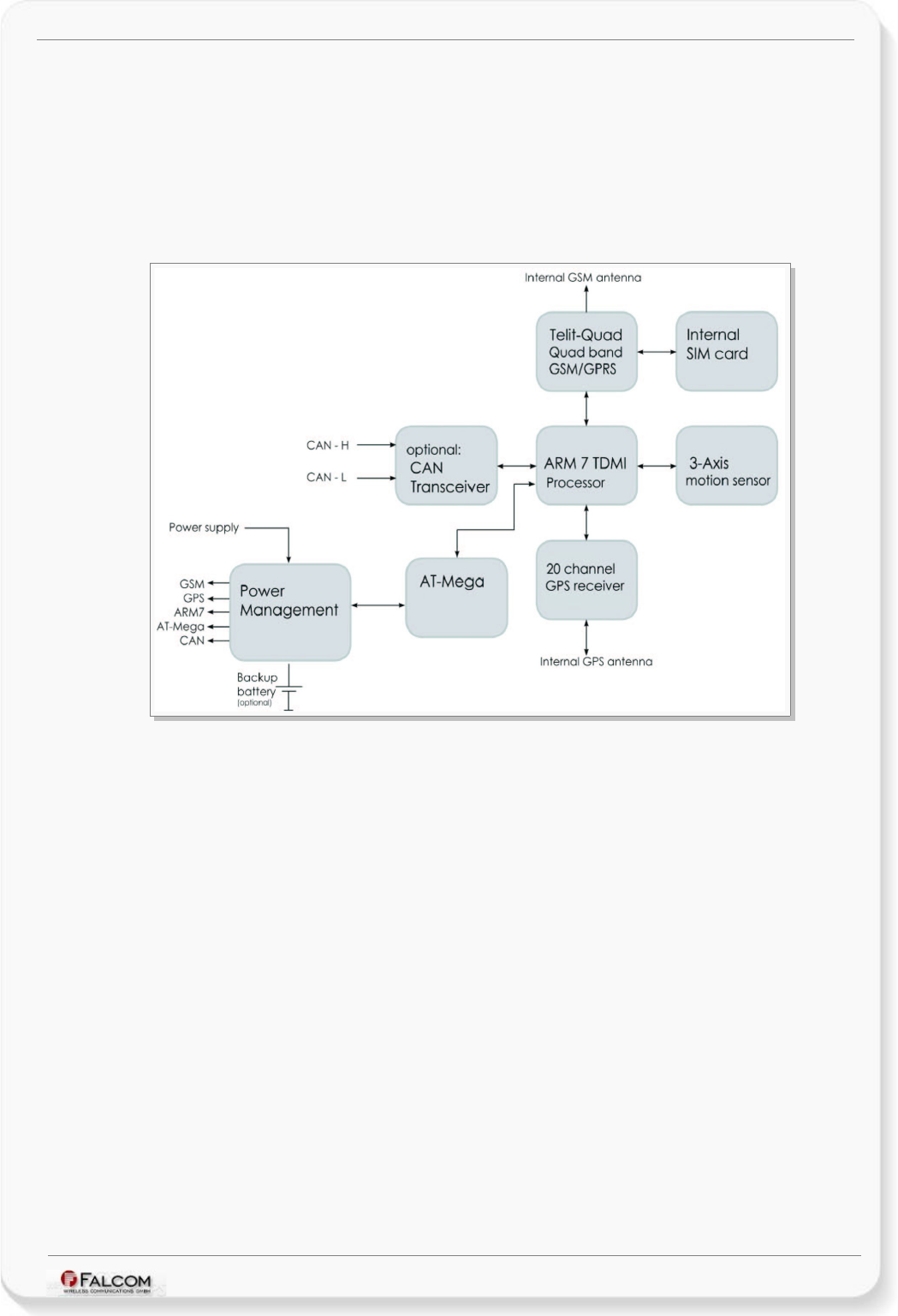
FOX HARDWARE MANUAL - PRELIMINARY - VERSION 1.0.0
Rechargeable Li-Polymer battery (see Ordering Guide),
PHYSICAL INTERFACES:
Power supply line,
3 x Multi-line I/O,
1 x Ignition;
RS232 port
Figure 1: FOX block diagram
This confidential document is a property of FALCOM and may not be copied or circulated without previous permission.
Page 7 of 31

FOX HARDWARE MANUAL - PRELIMINARY - VERSION 1.0.0
1.3 Related documents
Some others PDF documents such as FCC approval, application notes, Certificate
of Conformity R&TTE etc. are also available on the Web at: http://www.falcom.de/ in
the published download area.
In addition to this document, the following files comprise the full set of FALCOM FOX
product manuals:
NR PDF file name Description
[1] SteppIII_fox_bolero_lt_PFAL_Configuration_Com
mand_Set.pdf
Contains the description of the internal firmware and the supported
Configuration Command Set for the FALCOM STEPPIII, FOX and
BOLERO-LT.
[2] AppNotes_Transform_history_data.pdf Contains information of how to transform history data that are being
transmitted from FOX via TCP connection.
[3] AppNote_Remote_update.pdf Contains information of how to upgrade FALCOM AVL devices device
to a new firmware revision remotely via TCP.
[4] AppNotes_connecting_a_bar_code_scanner.pdf Describes how to connect a bar code scanner to a STEPPII,
STEPPIII, FOX etc. and store or transmit the scanned data.
[5] AppNotes_in_vehicle_mounting.pdf This document provides all the necessary information to allow your
FALCOM product to be properly and safely installed.
These PDF files are viewable and printable from Adobe Reader. If you do not have
the Adobe Reader installed, you can download it from
http://www.adobe.com.
This confidential document is a property of FALCOM and may not be copied or circulated without previous permission.
Page 8 of 31

FOX HARDWARE MANUAL - PRELIMINARY - VERSION 1.0.0
2 SECURITY
IMPORTANT FOR THE EFFICIENT AND SAFE OPERATION OF YOUR GSM-MODEM, READ
THIS INFORMATION BEFORE USE!
Your cellular engine FOX is one of the most exciting and innovative electronic
products ever developed. With it, you can stay in contact with your office, your
home, emergency services and others, wherever service is provided.
This chapter contains important information for the safe and reliable use of the FOX
device. Please read this chapter carefully before starting to use the cellular engine
FOX.
2.1 General information
Your FOX device utilizes the GSM standard for cellular technology. GSM is a newer
radio frequency („RF“) technology than the current FM technology that has been
used for radio communications for decades. The GSM standard has been
established for use in the European community and elsewhere. Your FOX is actually
a low power radio transmitter and receiver. It sends out and receives radio
frequency energy. When you use your modem, the cellular system handling your
calls controls both the radio frequency and the power level of your cellular
modem.
For the use of the acquired devices SIM cards are needed, which are not included
in the scope of delivery of the device. The SIM cards can be acquired e.g. by
specific providers. From the use of the SIM cards can result additional costs, which
are to be borne by the purchaser (client) of the devices. The seller does not cover
the extra costs for the use of the devices. The seller gives no recommendation for
the use of specific SIM cards and does not liable also for the fact that the devices
are usable with all available SIM cards. The seller also covers no other costs, that
are needed for the application of the customer in connection with this device.
2.2 Exposure to RF energy
There has been some public concern about possible health effects of using a GSM
modem. Although research on health effects from RF energy has focused for many
years on the current RF technology, scientists have begun research regarding
newer radio technologies, such as GSM. After existing research had been
reviewed, and after compliance to all applicable safety standards had been
tested, it has been concluded that the product is fit for use.
If you are concerned about exposure to RF energy, there are things you can do to
minimize exposure. Obviously, limiting the duration of your calls will reduce your
exposure to RF energy. In addition, you can reduce RF exposure by operating your
cellular modem efficiently by following the guidelines below.
This confidential document is a property of FALCOM and may not be copied or circulated without previous permission.
Page 9 of 31

FOX HARDWARE MANUAL - PRELIMINARY - VERSION 1.0.0
2.3 Efficient modem operation
In order to operate your modem at the lowest power level, consistent with
satisfactory call quality please take note of the following hints.
•
If your device has an extendible antenna, extend it fully. Some models allow
you to place a call with the antenna retracted. However, your FOX operates
more efficiently with the antenna fully extended.
•
Do not hold the antenna (if externally connected) when the modem is „IN
USE“. Holding the antenna affects call quality and may cause the modem to
operate at a higher power level than needed.
2.4 Driving
Check the laws and regulations on the use of cellular devices in the area where
you drive. Always obey them. Also, when using your FOX while driving, please pay
full attention to driving, pull off the road and park before making or answering a
call if driving conditions so require. When applications are prepared for mobile use,
they should fulfil road-safety instructions of the current law!
2.5 Electronic devices
Most electronic equipment, for example in hospitals and motor vehicles is shielded
from RF energy. However, RF energy may affect some malfunctioning or improperly
shielded electronic equipment.
2.6 Vehicle electronic equipment
Check your vehicle manufacturer’s representative to determine if any on board
electronic equipment is adequately shielded from RF energy.
2.7 Medical electronic equipment
Consult the manufacturer of any personal medical devices (such as pacemakers,
hearing aids, etc.) to determine if they are adequately shielded from external RF
energy.
Turn your FOX device OFF in health care facilities when any regulations posted in
the area instruct you to do so. Hospitals or health care facilities may be using RF
monitoring equipment.
2.8 Aircraft
Turn your FOX OFF before boarding any aircraft. Use it on the ground only with crew
permission. Do not use it in the air.
To prevent possible interference with aircraft systems, Federal Aviation
Administration (FAA) regulations require you to have permission from a crew-
member to use your modem while the plane is on the ground. To prevent
interference with cellular systems, local RF regulations prohibit using your modem
whilst airborne.
This confidential document is a property of FALCOM and may not be copied or circulated without previous permission.
Page 10 of 31

FOX HARDWARE MANUAL - PRELIMINARY - VERSION 1.0.0
2.9 Children
Do not allow children to play with your FOX device. It is not a toy. Children could
hurt themselves or others (by poking themselves or others in the eye with the
antenna, for example). Children could damage the modem or make calls that
increase your modem bills.
2.10 Blasting areas
To avoid interfering with blasting operations, turn your device OFF when in a
“
blasting area
” or in areas posted:
„turn off two-way radio“
. Construction crew
often uses remote control RF devices to set off explosives.
2.11 Potentially explosive atmospheres
Turn your FOX device OFF when in any area with a potentially explosive atmosphere. It
is rare, but your modems or their accessories could generate sparks. Sparks in such
areas could cause an explosion or fire resulting in bodily injury or even death.
Areas with a potentially explosive atmosphere are often, but not always, clearly
marked. They include fuelling areas such as petrol stations; below decks on boats;
fuel or chemical transfer or storage facilities; and areas where the air contains
chemicals or particles, such as grain, dust or metal powders.
Do not transport or store flammable gas, liquid or explosives, in the compartment of
your vehicle, which contains your modem or accessories.
Before using your modem in a vehicle powered by liquefied petroleum gas (such
as propane or butane) ensure that the vehicle complies with the relevant fire and
safety regulations of the country in which the vehicle is to be used.
2.12 Non-ionizing radiation
As with other mobile radio transmitting equipment users are advised that for
satisfactory operation and for the safety of personnel, it is recommended that no
part of the human body is allowed to come too close to the antenna during
operation of the equipment.
The radio equipment shall be connected to the antenna via a non-radiating 50-
Ohm coaxial cable.
The antenna shall be mounted in such a position that no part of the human body
will normally rest close to any part of the antenna. It is also recommended to use
the equipment not close to medical devices as for example hearing aids and
pacemakers.
This confidential document is a property of FALCOM and may not be copied or circulated without previous permission.
Page 11 of 31

FOX HARDWARE MANUAL - PRELIMINARY - VERSION 1.0.0
3 SAFETY STANDARDS
Your GSM/GPRS/GPS device complies with all applicable RF safety standards.
FOX meets the safety standards for RF receivers and the standards and
recommendations for the protection of public exposure to RF electromagnetic
energy established by government bodies and professional organizations, such as
directives of the European Community, Directorate General V in matters of radio
frequency electromagnetic energy.
This confidential document is a property of FALCOM and may not be copied or circulated without previous permission.
Page 12 of 31

FOX HARDWARE MANUAL - PRELIMINARY - VERSION 1.0.0
4 TECHNICAL DATA
4.1 Product features
Supply voltage range:
➢
Operating power supply voltage range of +10.8 V to
+35.0 V , suitable for direct connection to an automotive
+12V or +24V DC power source (car battery).
Power saving:
➢
8 different energy-saving modes - programmable with
PFAL commands.
Operating temperature range:
➢
-40°C to + 85°C (see chapter 4.1.2 for more details)
Physical characteristics:
➢
Size: 56.0 ± 0.1 mm x 172.0 ± 0.1 mm x 39.0 ± 0.1 mm
➢
Weight: ca. 229 gr.
➢C
able length: 1 m
Physical Interfaces:
➢
Eight-wire cable with an 8-pin connector on the end:
✔
3 x I/Os multi functional (Input/Output and Analog
Input),
✔
1 x Ignition (with software - controlled feature),
✔
1 x Power supply (with software - controlled feature)
✔
1 x Serial port (Rx, Tx), Baud rate is controlled by firmware
(by default 57600 bps), 8 data bits, no parity, 1 stop bit,
no flow control,
➢
SIM Card interface (for 1.8 and 3 V SIM cards)
➢
3 x LED indicators (free-programmable by the software)
Hardware options
➢CAN interface
– occupies 2 of 3 available I/Os (IO2 and IO3),
➢3D motion
sensor,
➢Micro-SD
- for additional memory (CAN),
Casing:
➢
Fully shielded
Certifications:
➢
Fully type approved confirming with R&TTE directive,
➢
FTA / FCC /PTCRB/ e1 / CE
Directive:
➢
RoHS compliant.
This confidential document is a property of FALCOM and may not be copied or circulated without previous permission.
Page 13 of 31

FOX HARDWARE MANUAL - PRELIMINARY - VERSION 1.0.0
Firmware:
➢
Embedded TCP/IP stack, including TCP, IP and SMTP
protocols,
➢
Accessible via PFAL commands,
➢
Upgrade via serial port and over the air (GPRS/TCP).
Internal Memory:
➢
2 MByte FLASH for configuration, data-logging and
firmware storage.
Evaluation kit:
➢
The FOX Evalboard is designed to test, evaluate and
make basis configuration to enable remote
monitoring/configuration of the FALCOM FOX. It provides
a sample configuration for further developing application.
4.1.1 Power consumption
To be defined.
4.1.2 Operating temperatures
Parameter Min. Typ. Max. Unit
Storage temperature (without internal battery) -40 +25 +90 °C
Operating temperature (without internal battery) -40 +25 +85 °C
GSM* (without internal battery)) -30 +25 +80 °C
Charging temperature (with internal battery enabled ***) 0 +25 +45 °C
Discharging temperature (with internal battery enabled ***) -20 +25 +60 °C
* These temperatures can affect the sensitivity and performance of the GSM engine.
** Using configuration $PFAL,Cnf.Set,EVICE.BAT.MODE=disabled
*** Using configuration $PFAL,Cnf.Set,DEVICE.BAT.MODE=auto
Table 1: Operating temperature
This confidential document is a property of FALCOM and may not be copied or circulated without previous permission.
Page 14 of 31

FOX HARDWARE MANUAL - PRELIMINARY - VERSION 1.0.0
4.1.3 GSM/GPRS features
GSM/GPRS core:
➢
Telit GE864-Quad module
➢
Quad-Band:
GSM 850, 900, DCS 1800, PCS 1900.
➢
Compliant to GSM Phase 2/2
+
Output power:
➢
Class 4 (2 W) at EGSM900/850
➢Class 1 (1 W) at GSM1800 and GSM 1900
GPRS connectivity:
➢
GPRS multi-slot class 10
➢
GPRS mobile station class B
DATA:
GPRS ⇒
➢
GPRS data downlink transfer: max. 85.6 kbps (see table 2).
➢
GPRS data uplink transfer: max. 42.8 kbps (see table 2).
➢
Coding scheme: CS-1, CS-2, CS-3 and CS-4.
CSD ⇒
➢
CSD transmission rates: 2.4, 4.8, 9.6, 14.4 kbps, non-
transparent, V.110.
SMS:
➢
Text mode.
GSM antenna:
➢
Internal.
Ringing tones:
➢
Offers a choice of 32 different ringing tones/melodies,
easily selectable with PFAL commands.
GPRS Coding scheme:
Coding scheme 1 Timeslot 2 Timeslots 4 Timeslots
CS-1: 9.05 kbps 18.1 kbps 36.2 kbps
CS-2: 13.4 kbps 26.8 kbps 53.6 kbps
CS-3: 15.6 kbps 31.2 kbps 62.4 kbps
CS-4: 21.4 kbps 42.8 kbps 85.6 kbps
Table 2: Coding schemes and maximum net data rates over air interface
Please note that, the values listed above are the maximum ratings which, in practice, are
influenced by a great variety of factors, primarily, for example, traffic variations and network
coverage.
This confidential document is a property of FALCOM and may not be copied or circulated without previous permission.
Page 15 of 31

FOX HARDWARE MANUAL - PRELIMINARY - VERSION 1.0.0
4.1.4 GPS features
GPS engine:
➢J
P13-S-LP FALCOM GPS product with SiRFstarIII chip set.
✔
High sensitive 20 channel, L1 1575.42 MHz, C/A code 1,023
MHz chip rate.
✔
SiRF GSW3
Accuracy:
✔
Position accuracy: < 10 m CEP without SA
Datum:
✔
WGS-84.
Time to First Fix (TTFF):
✔
Hot start < 1 sec., average
✔
Cold start
*
< 42 sec, average
Sensitivity:
✔
Tracking -159 dBm
Dynamic Conditions:
✔
Altitude 18,000 meters (60,000 feet) max.
✔
Velocity < 515 m/s (1000 knots) max.
✔
Max. update rate 1 Hz
Supported protocols:
✔
NMEA Msg.:
GLL, GGA, RMC, VTG, GSV, GSA
✔
FALCOM Msg.:
IOP, GSM, AREA, 3DP, BIN -
see
related documents [1].
Crystal oscillator (TCXO):
✔
Load sensitivity ± 10 % load change, 0.2 ± ppm
GPS antenna:
✔
Internal.
*Capable of cold starts of -144dBm.
This confidential document is a property of FALCOM and may not be copied or circulated without previous permission.
Page 16 of 31

FOX HARDWARE MANUAL - PRELIMINARY - VERSION 1.0.0
4.2 NMEA data message
FOX delivers data in the NMEA-0183 format.
Table 4
lists each of the NMEA and
FALCOM output messages supported by the FOX terminal and a brief description.
For further description about NMEA, see related documents
[1].
The running firmware offers the possibility to switch on or off each protocol listed
below for local use. With the help of PFAL commands supported by this firmware
these protocols can also be transferred via SMS, TCP, Data call and e-mail.
NMEA Description
GGA Time, position and fix type data.
GLL Latitude, longitude, UTC time of position fix and status.
GSA GPS receiver operating mode, satellites used in the position solution and DOP values.
VTG The number of GPS satellites in view satellite ID numbers, elevation, azimuth and SNR
values.
GSV The number of GPS satellites in view satellite ID numbers, elevation, azimuth and SNR
values.
RMC Time, date, position, course and speed data.
FALCOM Description
IOP The status of the digital/analog inputs and output ports and battery voltage (if battery available)
GSM The GSM operator, reception, registration status, GSM field strength, area code and cell ID.
AREA The state of 32 areas
3DP The state of the Motion Sensor (hardware option)
BIN User protocol including time, date, position, course and speed data.
Table 3: NMEA Output Messages
This confidential document is a property of FALCOM and may not be copied or circulated without previous permission.
Page 17 of 31

FOX HARDWARE MANUAL - PRELIMINARY - VERSION 1.0.0
5 FOX APPLICATION INTERFACE
5.1 Power supply
The power supply for the FOX unit has to be a single voltage source of V+IN = +10.8
V...+35.0 VDC. The operating voltage (V+IN) has to be permanently applied to the
FOX unit and able to provide sufficient current of up to 1.9 A.
The operating voltage (V+IN and GND) is protected against voltage spikes and reverse
polarity, but not against overvoltage.
NOTE: Operating voltage range must never be exceeded; care must be taken in
order to fulfill min/max voltage requirements.
5.1.1 Power supply pins (1 and 2) on the 8-pin connector
One +IN pin on the 8-pin connector is dedicated to connect the supply voltage,
and the GND pin for grounding.
Both +IN and GND pins serve for charging the internal Li-Polymer battery (option)
and powering the FOX device. FOX has an automatic power ON-function when
external power is applied. The power supply for the FOX is capable of utilizing
current ranging from V+IN = +10.8 V ... +35.0 VDC designed for automotive
application.
Signal name I/O Parameter Description
+IN I +10.8 V...+35.0 VDC. The
operating voltage must never
be exceeded.
Positive operating voltage.
For security reason, it is recommended to integrate
externally a 2A fuse link between interconnection plug (8-
pin connector) and d.c.-power source (see Fig 14).
GND - 0 V Ground (should be isolated from the vehicle Grounds)
5.1.2 Automatic shutdown
Automatic shutdown takes effect if:
•
under voltage is detected when battery level runs low and external power
supply is disconnected .
The automatic shutdown procedure is equivalent to the initiated power-down,
i.e. FOX logs off from the network and the software enters a secure state
avoiding loss of data.
5.2 Determining the External Equipment Type
Before you connect the serial port pins on the aforementioned terminals (DCE units)
to external equipment, you need to determine if the external hardware serial ports
are configured as DTE or DCE.
FOX is designed for use as a DCE device. Based on the aforementioned
conventions for DCE-DTE connections, it communicates with the customer
application (DTE) using the following signals:
FOX Terminal (DCE) to Application (DTE)
RxA <---------- TXD
TxA ----------> RXD
Table 4: The signalling definitions between DTE and DCE.
This confidential document is a property of FALCOM and may not be copied or circulated without previous permission.
Page 18 of 31
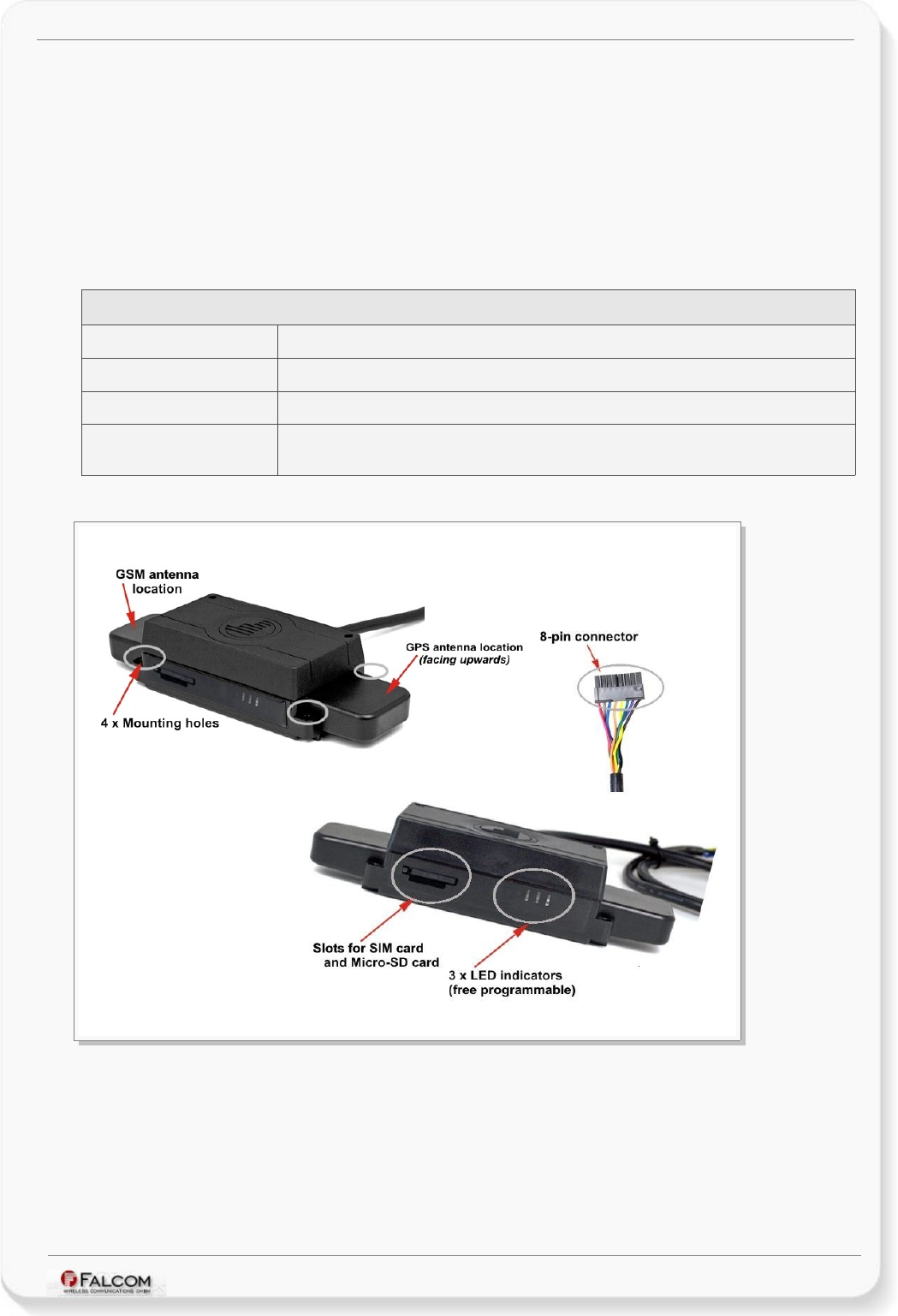
FOX HARDWARE MANUAL - PRELIMINARY - VERSION 1.0.0
6 HARDWARE INTERFACES
This chapter describes the hardware interfaces:
•
8-wire cable connector
•
SIM Card interface
•
LED indicators
•
Mounting holes
Interface specifications
8-wire cable connector Eight-wire cable with an 8-pin connector on the end and 1 meter cable length
SIM card interface It provides a SIM interface for small SIM cards (1.8/3V)
Optical LED indicators Firmware programmable LED.
Mounting holes 4 holes for attaching it to a suitable location (use M4x20 self tapping or machine
screws, not included).
Table 5: Interface specifications
Figure 2: Interface specifications
This confidential document is a property of FALCOM and may not be copied or circulated without previous permission.
Page 19 of 31

FOX HARDWARE MANUAL - PRELIMINARY - VERSION 1.0.0
6.1 8-wire connector, pin assignments
Figure 3: View of the 8-wire connector pin assignments
6.1.1 8-pin connector pinout
PIN COLOR NAME I/O DISCRIPTION LEVEL
1 Red +IN I
Power supply input. The power supply must
be able to meet the requirements of current
consumption. Care must be taken so that
the operating voltage applied to the terminal
stay within the voltage range. Applying a
voltage outside of the voltage range can
damage the module. For security reason, it
is recommended to integrate externally a 2A
fuse link between power source and FOX.
V+IN = + 10.8 ... + 35.0 V
Imax ≤ 2A
2 Brown GND - Ground. 0 V
3 Blue IGN I
General purpose input. Either connect it to
the vehicle ignition and use it for journey
START and STOP reports or connect it to
the operating voltage +IN and with the help
of an external switch you wakeup the FOX
device from IGN-Sleep mode (awaking from
this mode requires a HIGH signal). See also
chapter 6.1.2.4.
HIGH ≥+10.8 .. +35.0 V DC; LOW = 0V
4 Orange I/O1
5 Yellow I/O2
6 Green I/O3
I/O
Software controlled pin. Individually
configurable as digital input, analog input or
digital output.
OUT: 100 mA max. @ +0 .. +35.0V DC
IN: 0 V..+35.0V DC (High & Low = free-
programmable)
Analog : Up to 35.0 V DC/10 bits resolution
7 Purple RxA I
Serial port (receive data) for direct
connection to the host PC (configuration,
evaluation, firmware) or to the FOX Eval-
Board. If not used leave open.
V24, ±12 V
8 Black TxA O
Serial port (transmit data) for direct
connection to the host PC (transmitting
history data, output GPS protocols and
others) or to the FOX Eval-Board. If not
used leave open.
V24, ±12 V
Table 6: Pin description of the 8-wire connector
This confidential document is a property of FALCOM and may not be copied or circulated without previous permission.
Page 20 of 31

FOX HARDWARE MANUAL - PRELIMINARY - VERSION 1.0.0
6.1.2 Special pin description (Pins 4, 5, 6)
All these pins are controlled by the internal firmware. All of them can be configured
for used either as analog or digital input or digital output. Some examples how to
use them are given in sections below.
For IO lines that can work as input or output the corresponding output of this pin
has to be set to high (with PFAL command “$PFAL,IO4[5,6].Set=high”), otherwise 0V
will be measured
(and the device could be damaged).
6.1.2.1 How to use these pins as analog inputs
Because these pins can operate either as digital or analog inputs, they have to be
configured and calibrated with the help of PFAL commands supported by the
firmware before using as analog inputs.
Analog voltages of up to 35.0 V with a 10 bits resolution can be processed and
remotely evaluated by a server application. Pull-up resistor to a constant input
voltage allows for resistive transducers to ground, e.g. fuel sensor or thermistors.
To use these IOs as analog inputs, the following configuration is required in the
software.
PFAL,IO0[1,2].Config=AI,2,11
where 0, 1 and 2 are indices corresponding to IO1 (pin 4), IO2 (pin 5) and IO3 (pin 6)
respectively. While the value 2 and 11 are min. and max. voltages that will be used to
generate Low and High events, respectively. Detailed information can be found in
software manual “steppIII_fox_bolero_lt_PFAL_Configuration_Command_Set.pdf“.
↓ Connection example 1 (for I/O1 and I/O2):
Thus, an analog input can be connected to a temperature sensor (a NTC
resistor for instance). In the diagram below, it is used a fixed resistor from the
input voltage to the I/O 2, and a variable resistor (
Negative Temperature Coefficient
- whose resistance or capacitance decreases when temperature increases
) to ground. It is
possible to set a low temperature alarm and a high temperature alarm
(upper and lower values), passed to required temperature. Passage through
these thresholds will trigger an alarm. We recommend to use SMS or TCP as
alarm type with GPIOP as attachment protocol. The SMS can be received
on a mobile phone, modem or any GSM device when changes are notified.
The analog-to-digital converter (ADC) inside the unit has an input voltage
range from 0 to 2.5 V. An application example is shown in figure below:
Figure 4: Connection example 1 when using it as analog input.
This confidential document is a property of FALCOM and may not be copied or circulated without previous permission.
Page 21 of 31
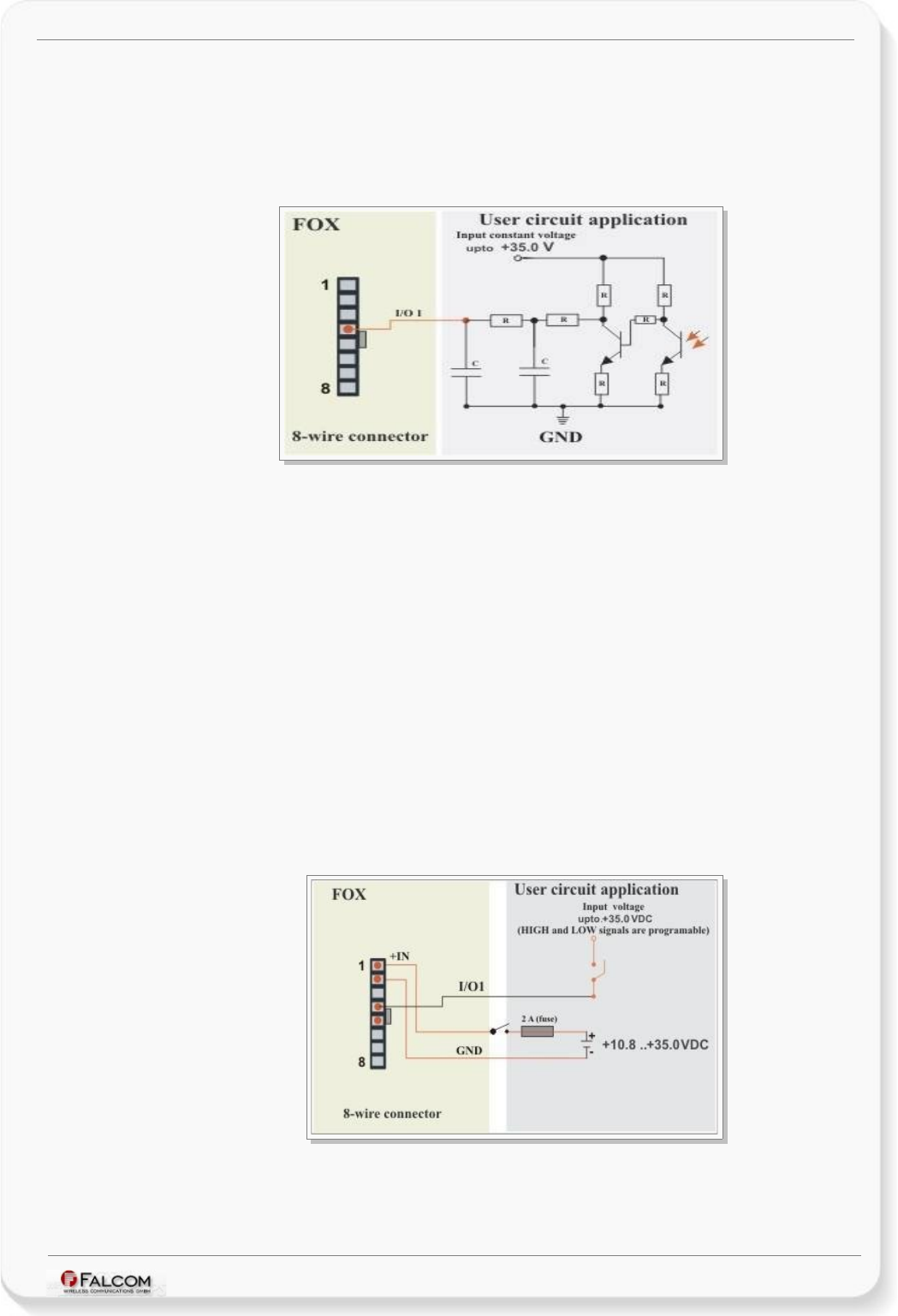
FOX HARDWARE MANUAL - PRELIMINARY - VERSION 1.0.0
↓ Connection example 2 (for I/O1 and I/O2):
An analog input can be connected to a tachometer generator. The
maximum output voltage of the tachometer should be + 35.0 V (see
illustrated example in figure below).
Both circuit examples (the NTC diagram above and the Tachometer below) are only
illustrations to show the aim of the analog inputs.
Figure 5: Connection example 2 when using it as analog input.
6.1.2.2 How to use these pins as digital inputs (Pin 4, 5, 6)
These pins are high active when used as digital inputs, so you can set VIN(LOW) and
VIN(HIGH) to any levels within the range from +0 to +35.0 VDC. The High and Low
levels can be set by using the PFAL command (e.g. PFAL,IO0[1,2].Config=DI,5,10) -
where 0, 1 and 2 are indexes corresponding to IO1 (pin 4), IO2 (pin 5) and IO3 (pin 6)
respectively. While the value 5 and 10 are min. and max. voltages that will be used to
generate Low and High events respectively.
Detailed information can be found in
software manual “steppIII_fox_bolero_lt_PFAL_Configuration_Command_Set.pdf“.
The figure below illustrates how these inputs can be used in practice. When the
running firmware detects input changes from High to Low or vice versa, it
generates a Falling or Rising edge Event respectively, therefore depending on the
alarm type, the FOX can react to the input changes and release different alarms
such as sending out an SMS, email message, TCP packet, opening a CSD
connection or activating an output port. The alarm type is user-dependant.
Figure 6: Connection example when using it as digital input
A completed circuit example for all inputs is attached in section 9.1.1.
This confidential document is a property of FALCOM and may not be copied or circulated without previous permission.
Page 22 of 31
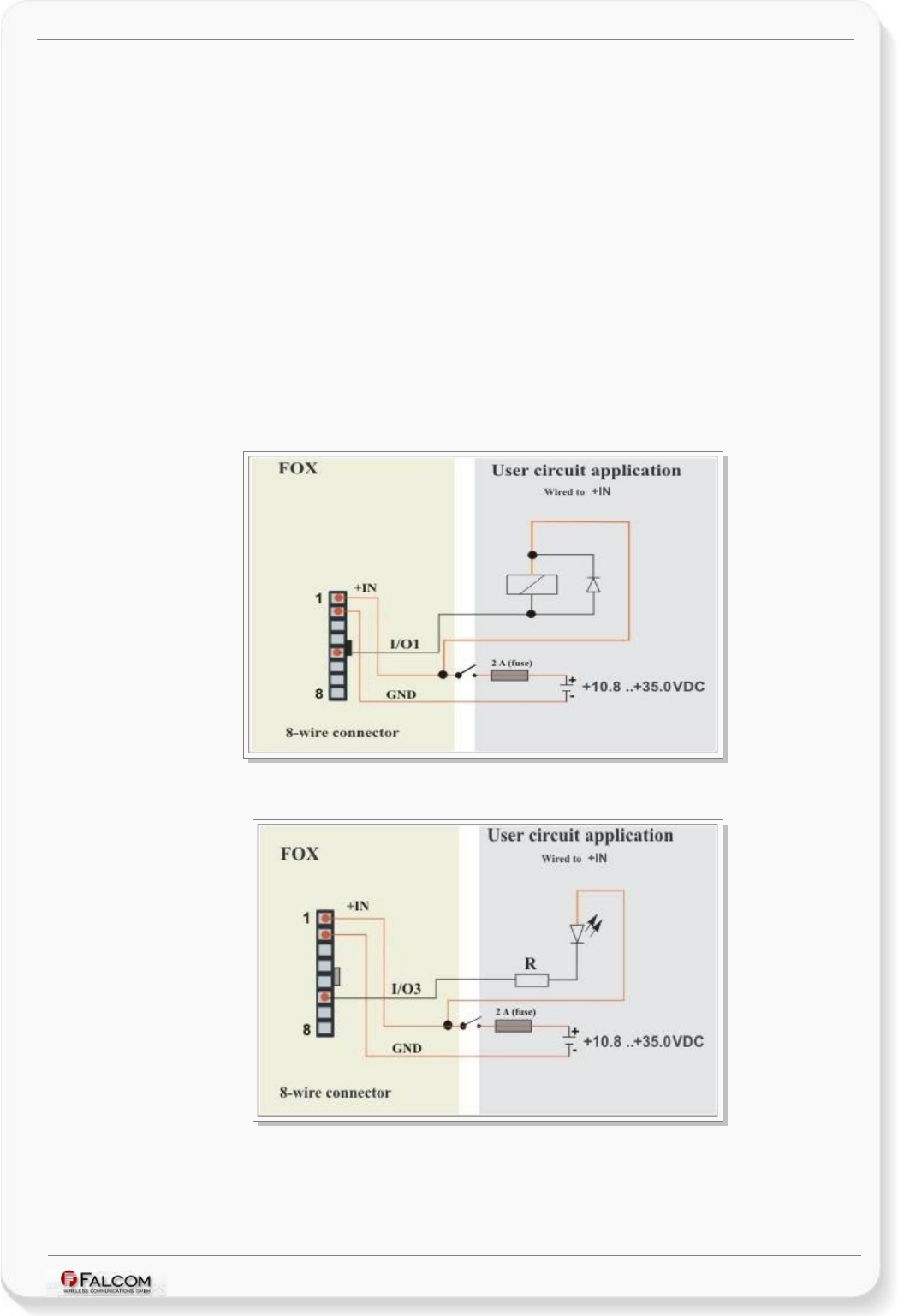
FOX HARDWARE MANUAL - PRELIMINARY - VERSION 1.0.0
6.1.2.3 How to use these pins as digital outputs (Pin 4, 5, 6)
The FOX device supports three IOs which can be used either as input or output.
These outputs are open collectors. They can be directly connected via resistors (R) to
LEDs, Relays etc., which need no more than
100 mA @ up to + 35.0 V DC
. The figures
below show the schematic of possible output connections. To use and activate these
outputs use the command $PFAL,IO4[5,6].Set=high[low,hpulse,lpulse,cyclic] for IO1, IO2
and IO3 respectively or you can configure an or more alarms that activate these
outputs when specific events occur (e.g. PFAL,Cnf.Set,AL0=IO.e8=redge:IO4.Set=cyclic,
1000,2000).
In order to evaluate this alarm, firstly send this configuration to the FOX
device and then trigger IGN-pin to High – as result the IO1 goes High for 1 sec and Low
for 2 sec. To set IO1 to Low, just execute the command
PFAL,IO4.Set=Low. For more
details how to activate an output and how to configure an alarm, refer to the
manual “steppIII_fox_bolero_lt_PFAL_Configuration_Command_Set.pdf“. Both
figures below show the schematic connections of how to use this output.
Please note
that, no power should be applied directly to an output pin without having e.g. a
resistor between output pin and power source.
Figure 7: Connection example 1 when using it to control an Relay.
Figure 8: Connection example 2 when using it to control an LED
This confidential document is a property of FALCOM and may not be copied or circulated without previous permission.
Page 23 of 31
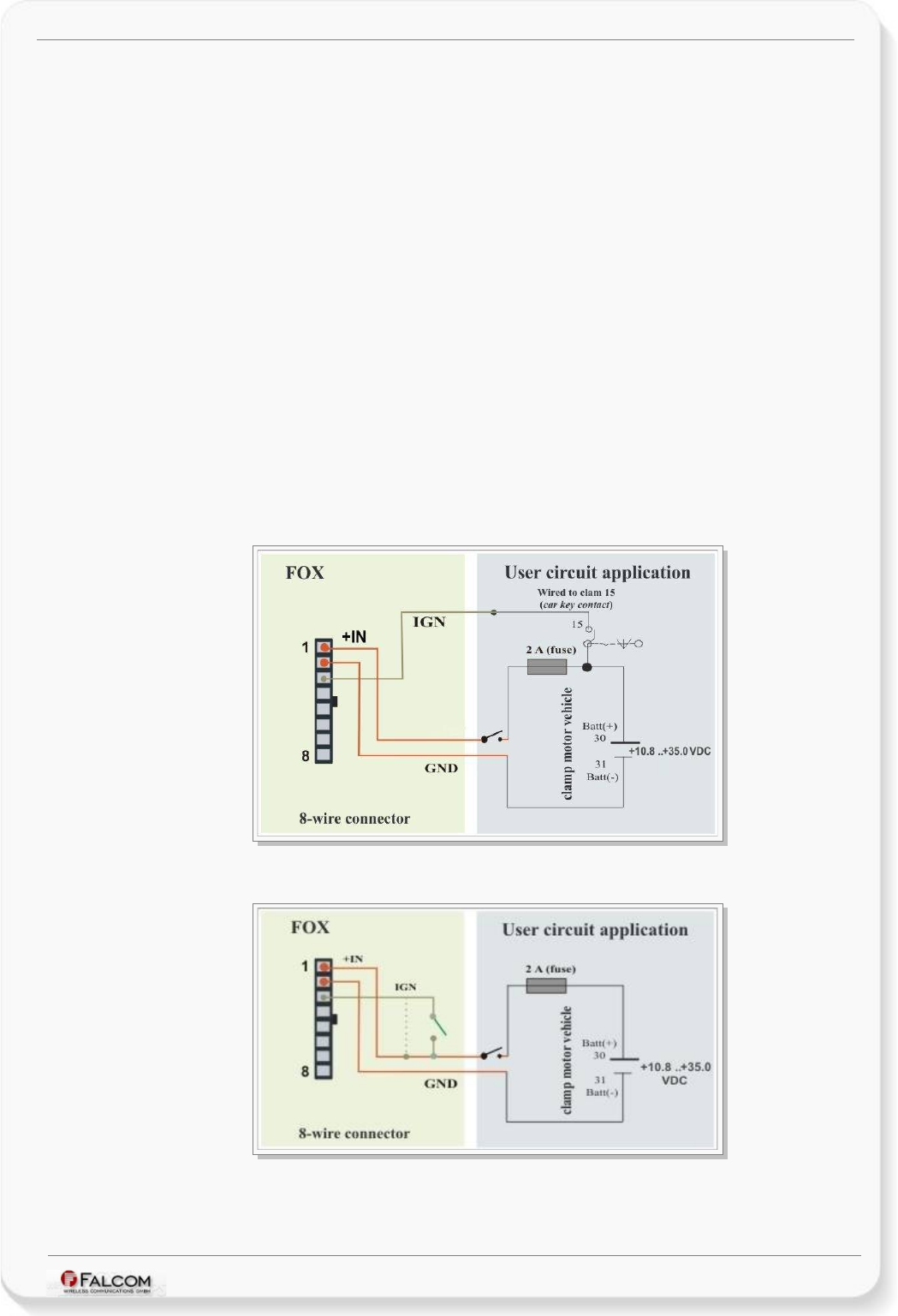
FOX HARDWARE MANUAL - PRELIMINARY - VERSION 1.0.0
6.1.2.4 How to use IGN pin(pin 3)
The IGN-pin has two functions:
✔
It wakes up the system FOX from the IGN-sleep mode (when sleeping),
✔
and can be used to monitor the vehicle ignition state, to report/store the
START and STOP of a trip by using the events
IO.e8=redge
and
IO.e8=fedge
for
START
and
STOP
respectively.
IGN-sleep mode is one of the eight supported energy-saving modes of operation in
which all unnecessary components are shut down. Once the device is awakened by
IGN high signal, it returns to full functionality.
Note that, the FOX device powers on automatically when external power is applied,
and IGN pin provides an additional “wake up” function for the IGN-sleep mode when it
is requested.
Using IGN pin you can configure the system to store a specific location or to deliver
an alarm SMS or TCP packet if an unauthorised entry to start your vehicle is
attempted. In such a case use the IGN generated event as a condition to start vehicle
tracking.
NOTE: All FOX devices that are shipped by the factory with an internal battery, are entered into the IGN-
sleep mode. Therefore, to switch that sleep mode off and take the FOX device back to full
functionality, just connect it to the d.c.-power source and then set IGN-pin to High.
Figure 9: Vehicle ignition monitoring by IGN line
Figure 9.1: Use IGN line for awaking FOX from IGN-Sleep
This confidential document is a property of FALCOM and may not be copied or circulated without previous permission.
Page 24 of 31
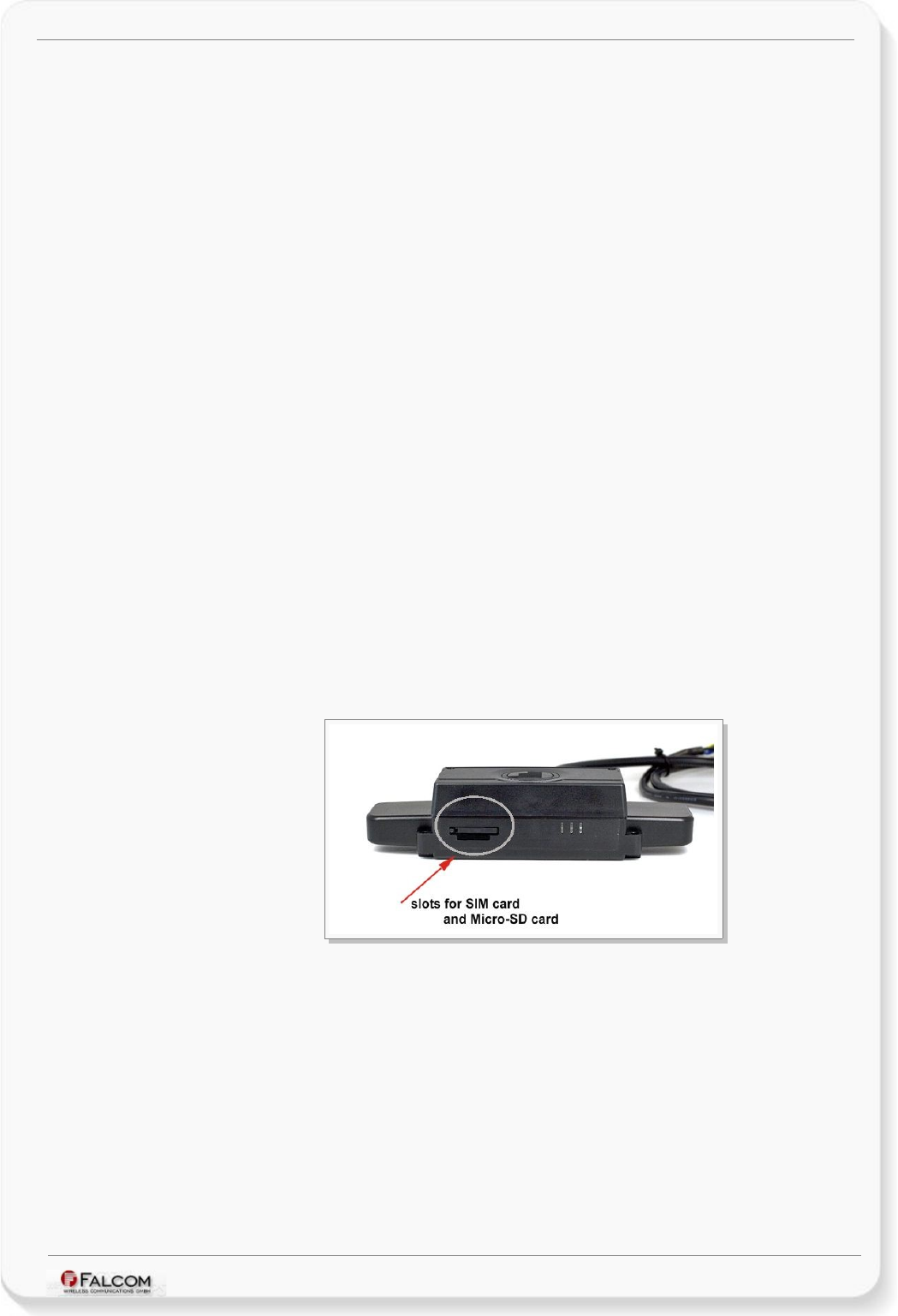
FOX HARDWARE MANUAL - PRELIMINARY - VERSION 1.0.0
6.1.2.5 Serial communication signals (RxA and TxA)
The FOX device incorporates a full duplex serial channel which allows two devices
to communicate directly with each other via the RS232 serial port. All supported
variable baud rates are software-controlled. It is recommended to use the FOX
Evalboard in order to communicate with the FOX device, as there you will find all
you need to evaluate with it.
This serial channel (RxA, TxA) operates at V24, ±12 V level. The signals on these pins
are obtained to RS232 compatible signal levels.
RxA This is the main receiving channel and is used to receive
software commands to the board from any software (e.g.
HyperTerminal). Moreover, the firmware update can also be
done through this serial port.
TxA
This is the main transmitting channel and is used to output
navigation, measurement, response and system data to
any software (e.g. HyperTerminal, FALCOM Workbench).
You may connect this port to a Bar code scanner and with the help of software
configuration (using the serial event Sys.eSerialData0) you may process the
incoming data from that scanner. Moreover, the incoming data on the serial line
may be forwarded/sent via TCP to an internet server and there processed/stored
into a database. Therefore, you have this data in real-time unimportant in which
country they have been scanned. The interface type and port settings of the bar
code scanner must be compatible with the FOX one. More about how to implement
such an application, refer to the related documents [4].
6.2 SIM card interface (Molex-91228-0002)
The figure below shows the SIM card reader interface of the FOX.
Figure 10: View of the SIM card interface
The SIM interface (the upper slot) controls an internal small 1.8/3 V SIM card. This
interface is fully compliant with GSM 11.11 recommendations concerning SIM
functions.
Note: The SIM card should not be removed, while the module is powered on. The
SIM card can only be removed when the FOX is shut down. To remove the
SIM card press the Eject button (see figure 10) then pull out the SIM card
holder.
This confidential document is a property of FALCOM and may not be copied or circulated without previous permission.
Page 25 of 31
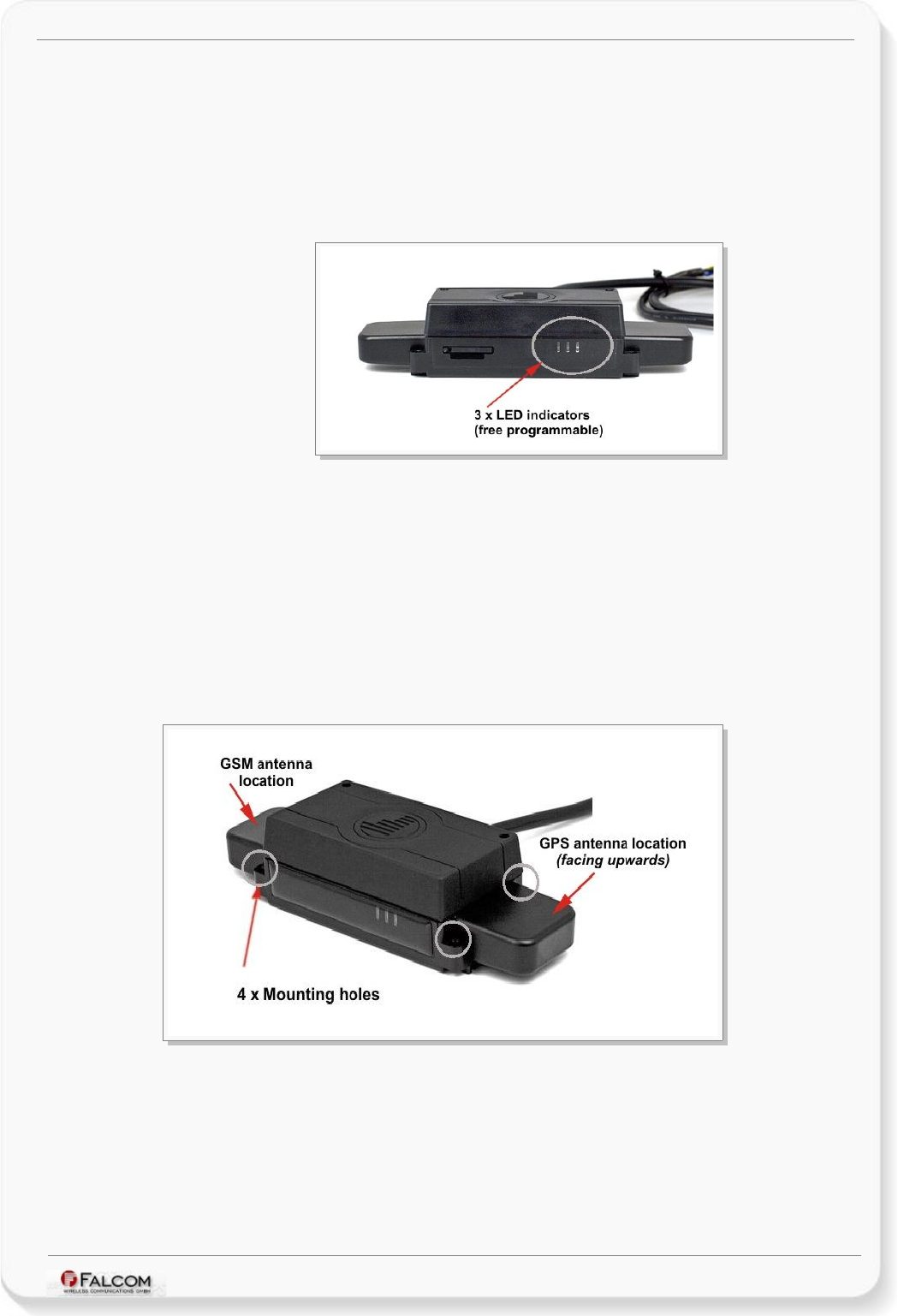
FOX HARDWARE MANUAL - PRELIMINARY - VERSION 1.0.0
6.3 LED’s description
The actual state of the FOX can be displayed by three LED’s on the front panel of
the unit. These programmable and accessible LEDs can be interfaced to the build-
in components to show their state. References how to customize the device
configuration can be found in the FOX software manual
“SteppIII_fox_bolero_lt_PFAL_Configuration_Command_Set.pdf”.
Figure 11: View of LED indicators
6.4 Interface E (Mounting holes)
The FOX compact unit provides 4 holes for attaching it to a suitable location. As a
reference for mounting holes use
Fig. 12
below in this section.
The terminal can be mounted in different locations such as on wall or in vehicle,
metal or non-metal sheets.
In order to avoid any damage during mounting of the device, it is required to use
properly screws.
There are no screws on the delivery pack.
Figure 12: View of the mounting holes
This confidential document is a property of FALCOM and may not be copied or circulated without previous permission.
Page 26 of 31
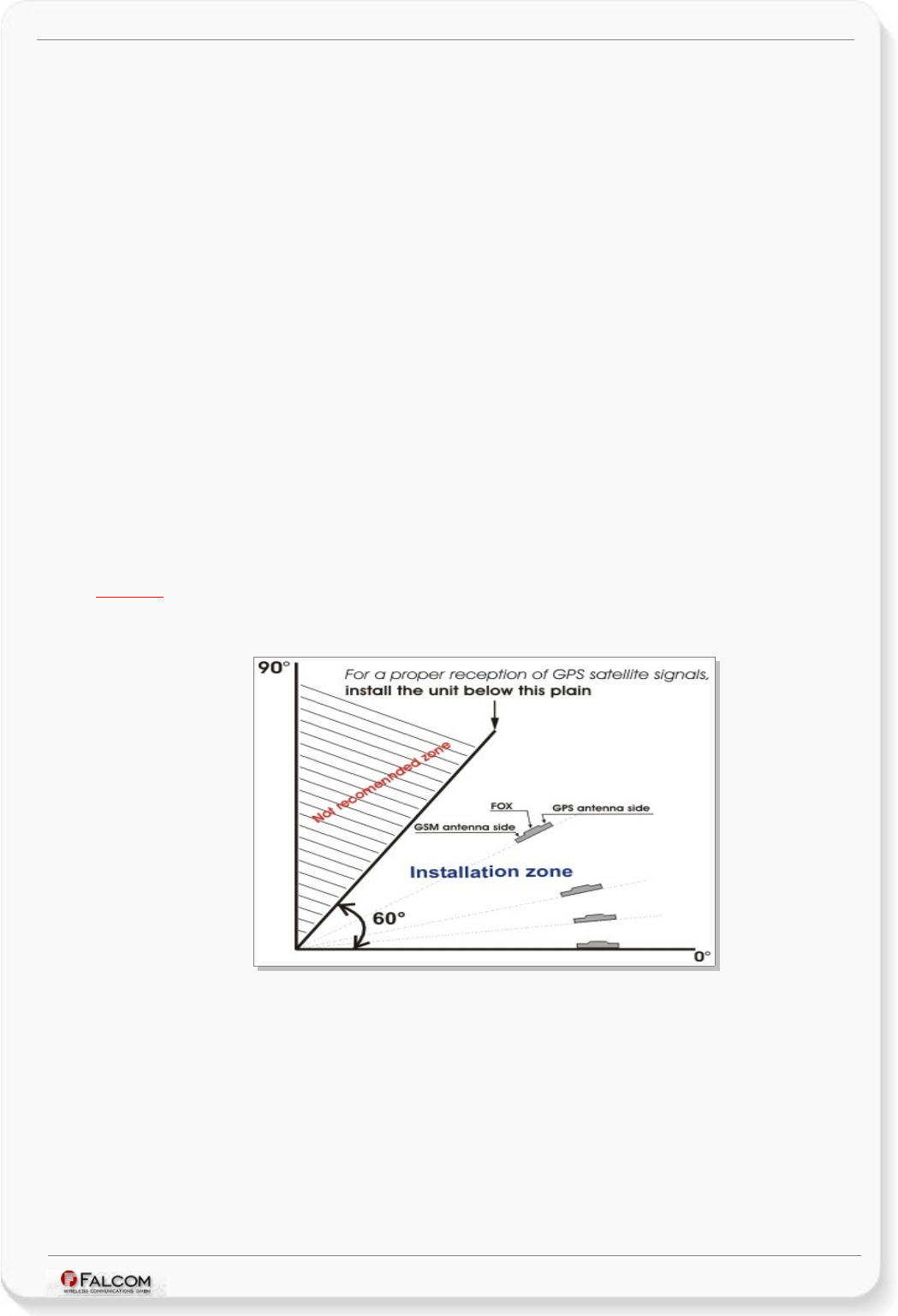
FOX HARDWARE MANUAL - PRELIMINARY - VERSION 1.0.0
6.4.1.1 Mounting the FOX device
The mounting location is very important, because it can affect the GPS
reception quality. Consider that the GPS receiving site is on the right side hand
of of the unit(viewing its front panel, see Fig 12).
To assure maximum visibility of the satellites that provide positioning data:
✔
Mount the FOX device on flat surfaces with the top facing towards the
sky, relatively free of obstructions.
✔
For a proper reception of GPS signals, orient the unit at an angle from
0 to 60 degrees relative to the horizon, and so that the housing itself
does not obstruct GPS signals (see Fig. 12.1).
✔
Additionally, the mounting location must also be chosen far enough
from electronic devices so that no interference takes place. Please,
contact your vehicle supplier for more information.
✔
Finally, fix the unit by using 4 screws M4x20 (or screws with different
length). Use a suitable screwdriver to perform the rotation.
✔
Failure to follow this installation instructions provided here, when installing this unit, can
seriously degrade the performance of a GPS system .
Caution : In order to comply with RF exposure requirements, install the terminal so that
a minimum distance of 20 cm can be maintained between the device and
persons.
Figure 12.1: Installation area relative to the horizon plain
All radio-transmitting devices send signals, which may cause interference in
different electronic devices (PC, television or electronic devices etc). To avoid
interference, place the terminal far enough from other electronic devices.
This confidential document is a property of FALCOM and may not be copied or circulated without previous permission.
Page 27 of 31
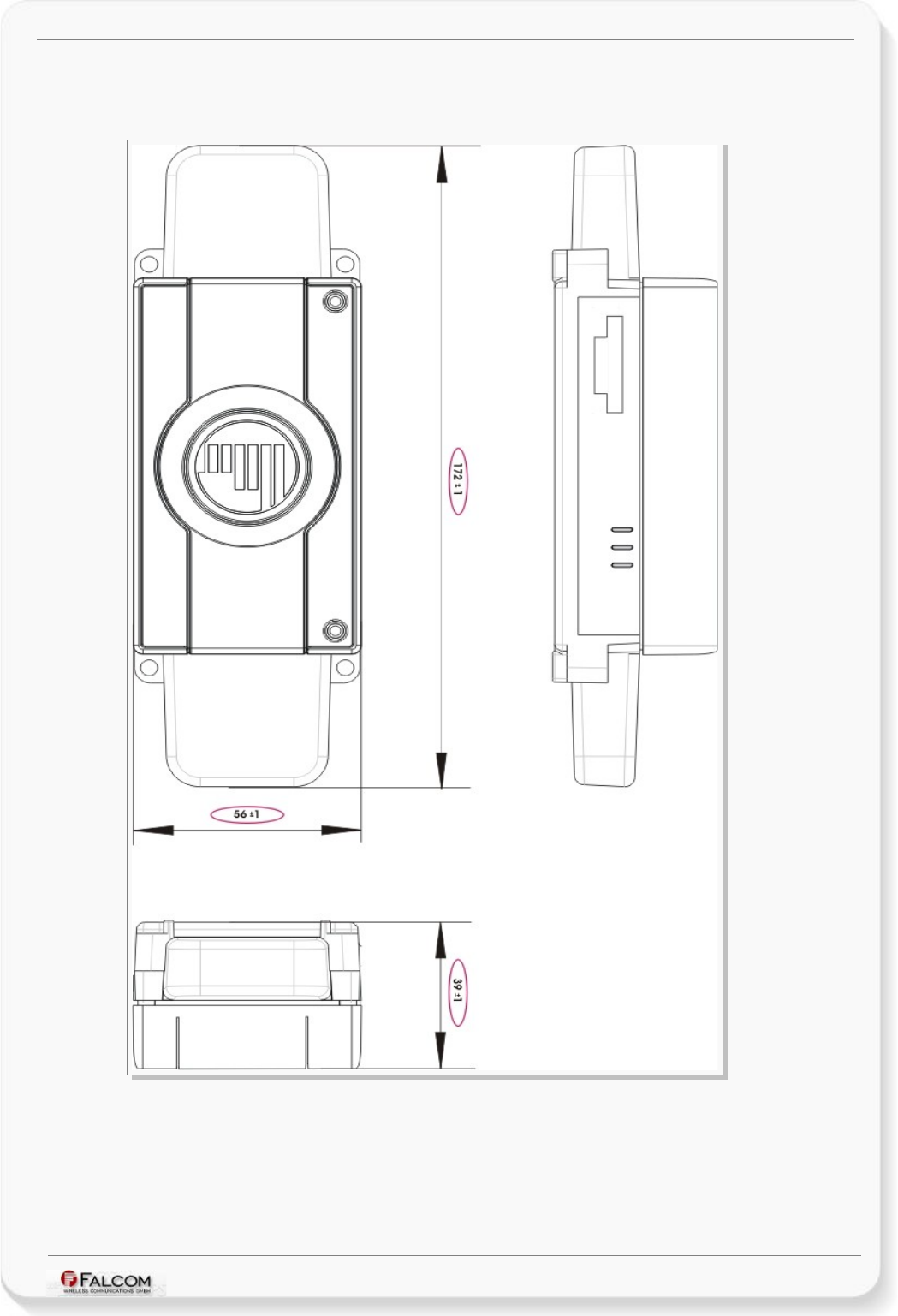
FOX HARDWARE MANUAL - PRELIMINARY - VERSION 1.0.0
7 HOUSING
Figure 13: Housing of the FOX.
This confidential document is a property of FALCOM and may not be copied or circulated without previous permission.
Page 28 of 31

FOX HARDWARE MANUAL - PRELIMINARY - VERSION 1.0.0
8 RF EXPOSURES
This device contains 850/900/1800/1900 MHz GSM/GPRS functions that is
operational in these frequencies respectively.
The FOX terminal contains 1800 MHz GSM functions that are not operational (must
not be used) in U.S. Territories. Filing is only applicable for 850MHz GSM/1900 MHz
PCS operations, whereby only these frequencies (850MHz GSM/1900 MHz PCS) are
possible to be used in U.S. Territories.
The external antennas used for this mobile transmitter must provide a separation
distance of at least 20 cm from all persons and must not be co-located or
operating in conjunction with any other antenna or transmitter.
Statement according to FCC part 15.19:
This device complies with Part 15 of the FCC Rules. Operation is subject to the
following two conditions:
•
this device may not cause harmful interference, and
•
this device must accept any interference received, including interference
that may cause undesired operation.
Statement according to FCC part 15.21:
Modifications not expressly approved by this company could void the user's
authority to operate the equipment.
Statement according to FCC part 15.105:
NOTE: This equipment has been tested and found to comply with the limits for a
Class B digital device, pursuant to Part 15 of the FCC Rules. These limits are
designed to provide reasonable protection against harmful interference in a
residential installation. This equipment generates, uses and can radiate radio
frequency energy and, if not installed and used in accordance with the
instructions, may cause harmful interference to radio communications.
However, there is no guarantee that interference will not occur in a particular
installation. If this equipment does cause harmful interference to radio or television
reception, which can be determined by turning the equipment off and on, the user
is encouraged to try to correct the interference by one or more of the following
measures:
•
Reorient or relocate the receiving antenna.
•
Increase the separation between the equipment and receiver.
•
Connect the equipment into an outlet on a circuit different from that to
which the receiver is connected.
•
Consult the dealer or an experienced radio/TV technician for help.
This confidential document is a property of FALCOM and may not be copied or circulated without previous permission.
Page 29 of 31
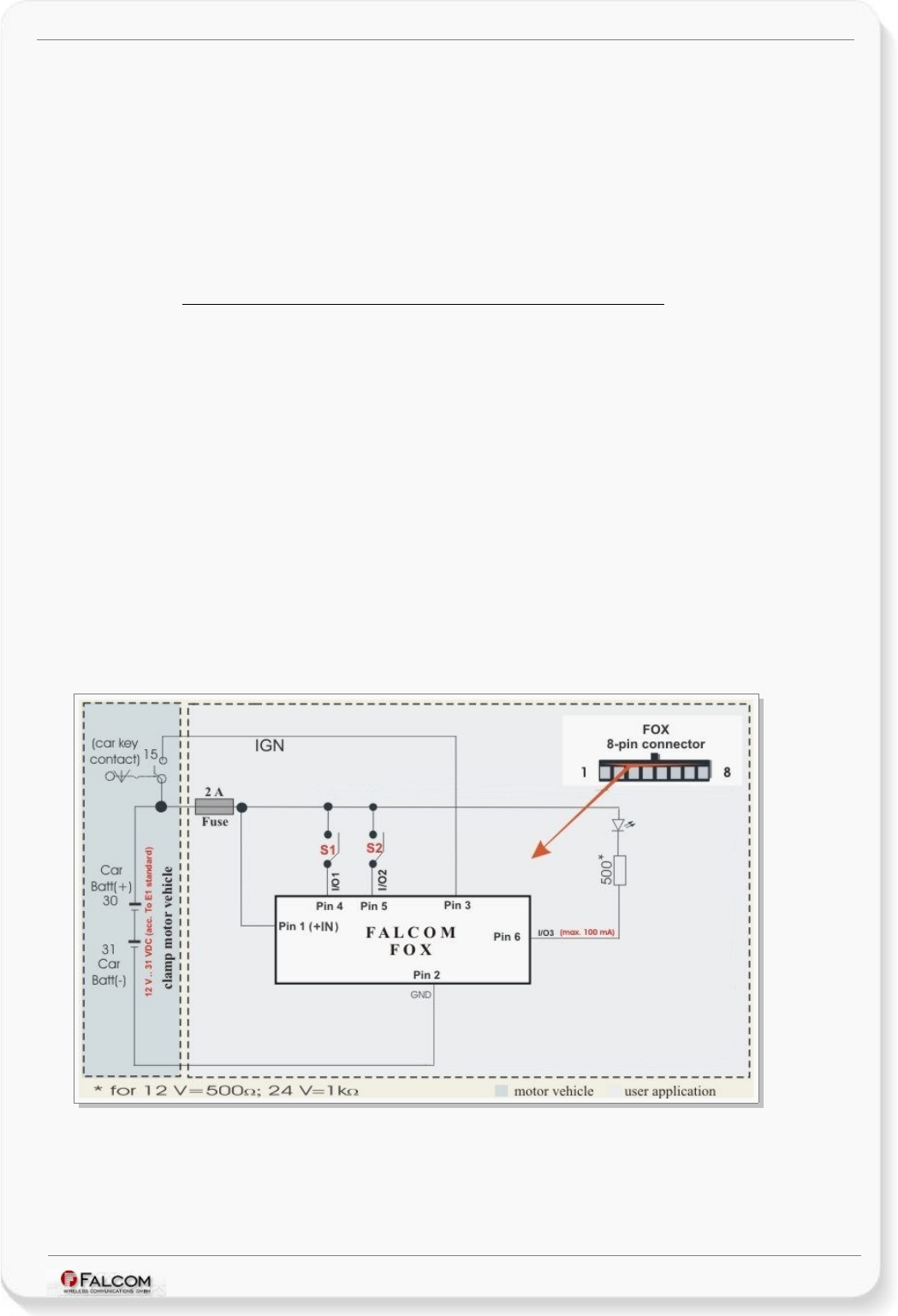
FOX HARDWARE MANUAL - PRELIMINARY - VERSION 1.0.0
9 APPENDIX
9.1 Schematics
The figure below illustrates a common schematic when you use the FOX hardware
for vehicle security. For detailed information, please, refer to the related
documents [AppNotes_in_vehicle_mounting.pdf].
9.1.1 Installation guidance for 8-wire cable connector
On the top of the schematic you can find the corresponding pin out of the 8-pin
connector.
When installing your FOX in a vehicle, you will not only be able to track and locate the
vehicle all the time, but also you will be automatically notified when disagreements
with your configuration loaded into the FOX device occur. Furthermore, the firmware-
controlled outputs allow you to lock/unlock doors etc. While the IGN input line can be
used to monitor the vehicle ignition key, two other inputs can be used as digital or
analog and may be individualized for each customer.
Note that, the output of the FOX and +IN must connected on the same voltage level as
the supply voltage +IN operates.
The operating voltage range MUST never be exceeded. For security reason, it is
recommended to integrate externally a 2A fuse link between the positive wire of the
FOX (+IN) and d.c. - power source.
Please note that, the ground pin of the FOX unit should be isolated from the
vehicle body to avoid ground loops.
Figure 14: Schematic example of installation guidance.
This confidential document is a property of FALCOM and may not be copied or circulated without previous permission.
Page 30 of 31

FOX HARDWARE MANUAL - PRELIMINARY - VERSION 1.0.0
9.2 What should be considered when using the FOX device
FOX is a device controlled by the operating firmware. In order to start applications
with FOX and to obtain maximum benefit from operating firmware, please, refer to
the manual “SteppIII_fox_bolero_lt_PFAL_Configuration_Command_Set.pdf”.
This confidential document is a property of FALCOM and may not be copied or circulated without previous permission.
Page 31 of 31
